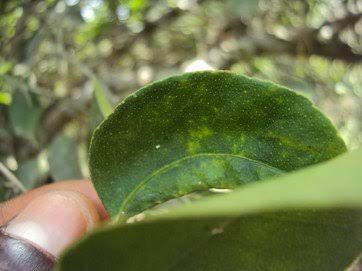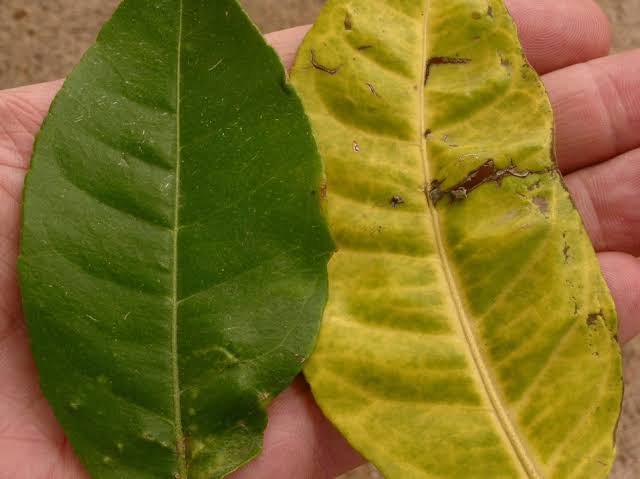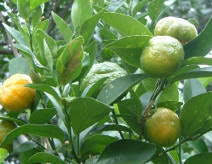Citrus tristeza virus, scientifically known as CTV, is a harmful pathogen that affects citrus trees. This virus is a major concern for citrus growers worldwide, causing severe damage to citrus orchards.
CTV primarily spreads through aphids, tiny insects that feed on the sap of citrus trees. When an infected aphid feeds on a healthy citrus tree, it can transmit the virus, leading to the development of citrus tristeza disease. This disease affects various citrus species, including oranges, lemons, and grapefruits.
One of the distinctive features of Citrus tristeza virus is its ability to induce diverse symptoms in infected trees. These symptoms may include yellowing of leaves, vein corking, and stunted growth. In severe cases, the virus can lead to the death of the tree, posing a significant threat to citrus agriculture.
Efforts to manage Citrus tristeza virus include the use of disease-resistant citrus varieties, implementing strict quarantine measures, and controlling aphid populations. Researchers and citrus farmers collaborate to develop strategies to mitigate the impact of this virus on citrus orchards.
Despite ongoing efforts, Citrus tristeza virus remains a persistent challenge for the citrus industry, emphasizing the importance of continued research and global cooperation in finding effective solutions to protect citrus crops from this devastating pathogen.
Read Also: Appearance, Features and Farming Guide of Cod Fish
Plants Affected by Citrus Tristeza Virus

Citrus tristeza virus (CTV) poses a significant threat to various citrus species, affecting a wide range of plants within the citrus genus. Commonly impacted citrus varieties include oranges, lemons, grapefruits, and limes. This virus can manifest differently in different species, leading to a variety of symptoms and outcomes.
Oranges, being a staple in the citrus industry, are particularly vulnerable to CTV. Infected orange trees may exhibit symptoms such as leaf yellowing, vein corking, and reduced fruit quality. The virus can compromise the overall health of orange trees, impacting fruit yield and quality.
Lemons, another popular citrus fruit, can also fall victim to Citrus tristeza virus. Infected lemon trees may display similar symptoms to oranges, including leaf discoloration and stunted growth. The virus’s impact on lemon trees can result in reduced productivity and economic losses for citrus growers.
Grapefruits, known for their distinct flavor, are not immune to the detrimental effects of CTV. Infected grapefruit trees can suffer from symptoms such as leaf distortion and reduced fruit size. The consequences of CTV on grapefruits contribute to concerns within the citrus industry about the economic viability of affected orchards.
Limes, often used for their tangy taste, can also be affected by Citrus tristeza virus. Infected lime trees may experience leaf yellowing, which can compromise the tree’s ability to produce healthy fruit. This poses challenges for lime growers who rely on healthy orchards for a consistent harvest.
In addition to these major citrus varieties, CTV can affect various hybrids and ornamental citrus trees, widening its impact across the citrus genus. The ability of Citrus tristeza virus to target diverse citrus species emphasizes the importance of comprehensive strategies for managing and mitigating its effects on citrus agriculture.
Damages Caused by Citrus Tristeza Virus

Citrus tristeza virus (CTV) inflicts significant damage on citrus trees, leading to a range of detrimental effects that impact both the health of individual trees and the overall productivity of citrus orchards.
1. Stunted Growth: Infected citrus trees often exhibit stunted growth as a result of Citrus tristeza virus. The virus disrupts normal physiological processes within the tree, hindering its ability to develop and reach optimal size.
2. Leaf Yellowing: One of the prominent symptoms of CTV infection is the yellowing of leaves, a condition known as chlorosis. This occurs due to the interference with chlorophyll production, affecting the tree’s capacity for photosynthesis and nutrient absorption.
3. Vein Corking: Citrus tristeza virus induces a condition known as vein corking, where the veins of infected leaves become woody and distorted. This disrupts the vascular system of the tree, impeding the flow of water and nutrients.
4. Reduced Fruit Quality: The virus has a detrimental impact on the quality of citrus fruits. Infected trees may produce smaller, misshapen, or discolored fruits, rendering them less marketable and diminishing economic returns for citrus growers.
5. Tree Decline and Death: In severe cases, CTV can lead to the decline and eventual death of infected citrus trees. The cumulative effect of the virus on tree health, coupled with compromised fruit production, can result in the removal of entire orchards to prevent further spread.
6. Economic Losses: Citrus tristeza virus poses a significant economic threat to the citrus industry. Reduced fruit quality and tree mortality contribute to substantial financial losses for citrus growers, impacting local economies and the global citrus market.
7. Transmission to Rootstocks: CTV can also be transmitted to citrus rootstocks, which are commonly used in citrus cultivation to provide disease resistance and control tree size. When rootstocks become infected, it undermines the effectiveness of these disease management strategies.
Efforts to mitigate the damages caused by Citrus tristeza virus involve the development of disease-resistant citrus varieties, implementation of strict quarantine measures, and integrated pest management strategies to control aphid vectors. The ongoing research and collaborative initiatives aim to find sustainable solutions to protect citrus orchards from the devastating impact of CTV.
Read Also: Health, Lifespan and Farming Guide of Catfish
Control and Preventive Measures

Controlling and preventing the spread of Citrus tristeza virus (CTV) is crucial for safeguarding citrus orchards. Various measures are employed to manage the virus and minimize its impact on citrus trees:
1. Use of Disease-Resistant Varieties: Planting citrus varieties that are resistant to CTV is a fundamental strategy. Resistant cultivars can withstand or exhibit reduced susceptibility to the virus, providing a natural defense against infection.
2. Budwood Certification Programs: Implementing strict budwood certification programs helps ensure that citrus nursery stock is free from CTV. Certified budwood is sourced from healthy, disease-free trees, reducing the risk of introducing the virus to new orchards.
3. Rigorous Quarantine Measures: Enforcing quarantine regulations is essential to prevent the movement of infected plant material. This includes restrictions on the transport of citrus trees, fruits, and other materials that may carry the virus to uninfected areas.
4. Vector Control: Managing the populations of aphid vectors is critical in controlling the spread of CTV. Insecticides and other integrated pest management strategies are employed to reduce aphid infestations and limit the transmission of the virus.
5. Rootstock Selection: Choosing appropriate rootstocks with resistance to Citrus tristeza virus is a key consideration in citrus orchard management. Resistant rootstocks can provide an additional layer of protection, preventing the virus from spreading through the root system.
6. Orchard Sanitation: Regularly removing and destroying infected trees helps prevent the further spread of CTV within an orchard. This practice is crucial for containing the virus and maintaining the overall health of the citrus grove.
7. Educational Outreach: Providing education and training to citrus growers about the symptoms of CTV, its transmission, and preventive measures is essential. Increased awareness empowers growers to implement effective strategies and detect potential infections early.
8. Research and Development: Ongoing research to understand the biology of Citrus tristeza virus and develop new control methods is vital. Research efforts focus on finding sustainable solutions, such as breeding programs for resistant cultivars and innovative vector management techniques.
Constant vigilance, collaboration, and adherence to best practices are essential components of a comprehensive approach to managing CTV.
Frequently Asked Questions (FAQs) About Citrus Tristeza Virus
1. Q: What is Citrus tristeza virus (CTV)?
A: Citrus tristeza virus, or CTV, is a pathogenic virus that affects citrus trees, leading to various symptoms and potential economic losses for citrus growers.
2. Q: How is Citrus tristeza virus transmitted?
A: CTV is primarily transmitted through aphids, small insects that feed on citrus trees. Infected aphids can spread the virus to healthy citrus trees when they feed on their sap.
3. Q: What are the common symptoms of CTV infection in citrus trees?
A: Common symptoms include leaf yellowing (chlorosis), vein corking, stunted growth, and, in severe cases, the decline and death of infected trees. Fruit quality may also be compromised.
4. Q: Can Citrus tristeza virus be controlled or managed?
A: Yes, various measures can be employed to control and manage CTV. These include using disease-resistant citrus varieties, implementing strict quarantine measures, controlling aphid vectors, and adopting orchard sanitation practices.
5. Q: Are all citrus varieties equally susceptible to CTV?
A: No, susceptibility varies among citrus varieties. Some cultivars may be more resistant or less affected by the virus. Selecting disease-resistant varieties is an important strategy for managing CTV.
6. Q: How does CTV impact the citrus industry economically?
A: CTV can lead to reduced fruit quality, stunted growth, and even the death of citrus trees, resulting in economic losses for citrus growers. Infected orchards may need to be removed, further impacting the industry.
7. Q: What preventive measures can be taken to avoid CTV spread?
A: Preventive measures include using disease-resistant varieties, implementing budwood certification programs, enforcing quarantine measures, controlling aphid vectors, selecting resistant rootstocks, practicing orchard sanitation, and promoting educational outreach.
8. Q: Can CTV be transmitted through citrus fruit consumption?
A: No, Citrus tristeza virus is not transmitted through the consumption of citrus fruits. The primary mode of transmission is through aphid vectors, and the virus does not pose a direct threat to human health.
9. Q: How important is research in managing CTV?
A: Research is crucial for understanding the biology of CTV, developing disease-resistant cultivars, and finding innovative control methods. Ongoing research efforts contribute to sustainable strategies for managing and mitigating the impact of Citrus tristeza virus.
Read Also: Gym Workouts: A Guide to Achieving Your Fitness Goals

